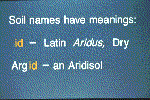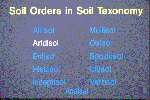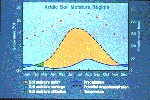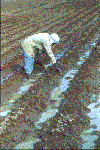Classification, Properties, and Management of Aridisols
Soil Taxonomy
 |
This presentation illustrates the classification, properties, and
management of aridic soils using the technical language of soil
classification developed in the book Soil Taxonomy
by the Natural Resource Conservation
Service of the United States Department of Agriculture, formerly
the Soil Conservation Service. Through its use, reproducible soil
identification can be made anywhere in the world. Published in 1975,
Soil Taxonomy is now used by more than 45 countries
as a national soil classification system. Since 1975, the knowledge
gained through world application has led to significant changes
in the system. The current
edition (9th) can be accessed on the Web.
|
 |
Soil Taxonomy classifies soils at six levels or categories
based on diagnostic soil horizons and soil climatic conditions.
The broadest category is Order. Lower categories, in which
classes are successively more narrowly defined, are the Suborder,
Great Group, Subgroup, Family, and Series.
|
 |
Soil class names have meaning. They are composed of descriptive
syllables, mostly from Latin and Greek roots. For example, the syllable
"id" is used as a suffix to all names in the Aridisol
Order. "Id" comes from the Latin word aridus meaning
dry.
|
 |
The Aridisol soil Order is one of eleven Orders recognized in Soil
Taxonomy. (Originally ten Orders, the eleventh, Andisol, has
been added to distinguish at the highest level those soils derived
from volcanic-glass.) Before we examine the taxonomic hierarchy
of the Aridisol Order, we'll discuss the two main criteria used
to classify Aridisols: the aridic soil moisture regime and diagnostic
soil horizons.
|
 |
Five soil moisture regimes characterize the presence or absence
of groundwater or water held at a tension in the soil at which it
is available to most plants. This graph depicts the soil water balance
in an aridic soil moisture regime. The orange area represents the
soil moisture deficit which occurs when evapotranspiration exceeds
precipitation. Under these conditions plants do not have water continuously
available except for brief periods.
|
 |
Thus, all Aridisols require irrigation to support cultivated crops.
|
Introduction to Aridic Soils | Soil Taxonomy
| Introduction to Soil Horizons | The Horizons | Suborders and Great
Groups | Argid Suborder | Orthid
Suborder | Subgroups | Families
| Non-Aridisols | Irrigation
| Saline Soils | Sodic
and Saline-Sodic Soils | Final Considerations
|

